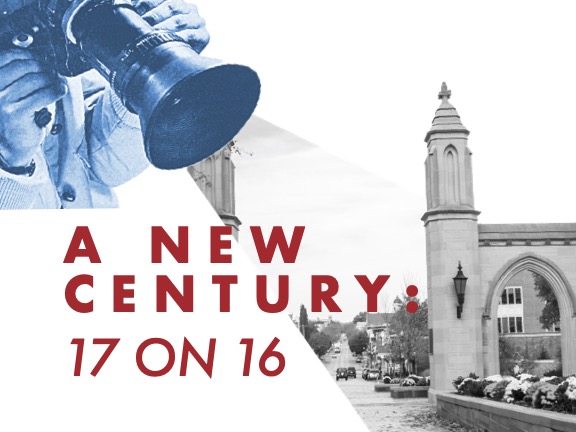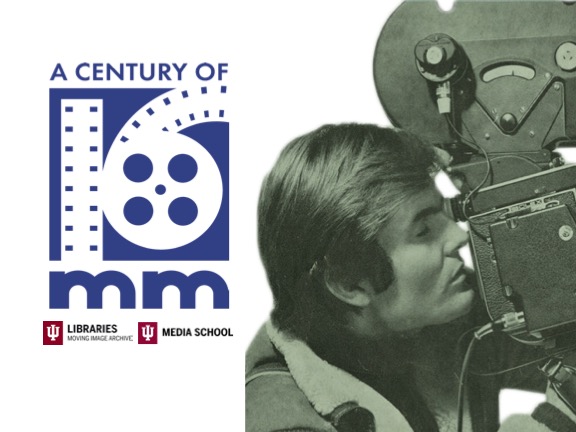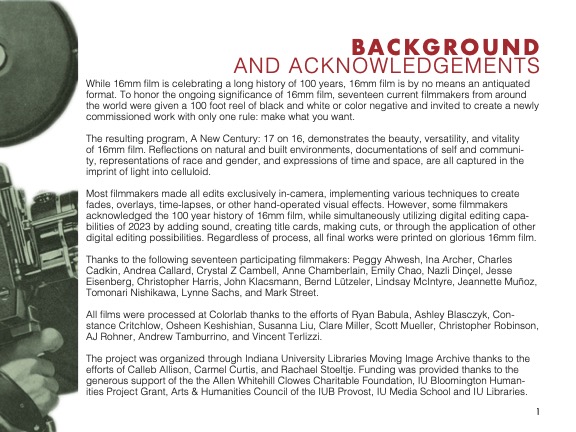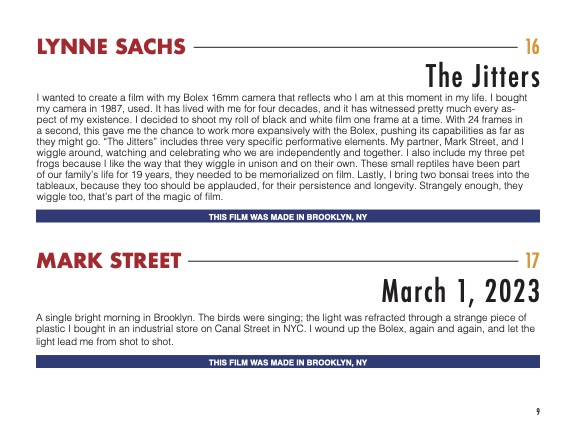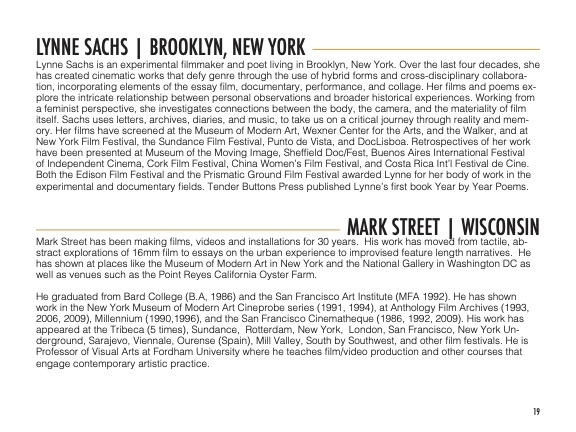
A Century of 16mm
Indiana University Moving Image Archive
July 25, 2023
Main page: https://centuryof16mm.com/?page_id=33
Commissioned films: https://centuryof16mm.com/?page_id=142
Schedule: https://centuryof16mm.com/?page_id=1483
Celebrating a Rich History
2023 will mark the 100-year anniversary of the introduction of non-flammable 16mm safety motion picture film, a format that played an essential role in the development of cinema over much of the twentieth century. Eastman Kodak developed and marketed 16mm as a smaller, less expensive, safer alternative to the 35mm nitrate film, then used for shooting all of Hollywood’s product and for the prints shown in America’s thousands of movie theaters. But 16mm turned out to be much more than a type of “small-gauge” celluloid stock with the familiar rectangular aspect ratio of 1.3 to 1. It was a novel technology for creating, circulating, and screening films, requiring special—but not necessarily costly or complicated–cameras and projectors. Designed from the outset not to compete with or replace 35mm, 16mm served, encouraged, and expanded non-theatrical cinema, a potentially enormous field (and market).
Particularly boosted by educators, advertisers, manufacturers, and the American military, 16mm had achieved an extraordinary level of success by the immediate post-World War II years. 16mm cameras opened vast new possibilities for amateur filmmakers, political activists, academic researchers, and experimental artists, for local entrepreneurs, government agencies, public relation firms, and major corporations. Most home movies were shot and shown using low-cost consumer-oriented 8mm equipment, but outside American dens and family rooms 16mm thrived as a flexible, durable, and efficient way of delivery for all manner of audio-visual content. As one measure of its ubiquity, consider that in 1959, approximately 596,000 16mm projectors were in use in the US; by 1966, the number had grown to 934,000, almost all of which were found outside the home.
Typically designed to be portable and easy-to-operate but also available in a range of specialized models intended for close analysis of motion picture images or for looped sales displays, 16mm projectors immeasurably expanded the reach of cinema to a host of occasions and sites, including–but well beyond–classrooms, churches, museums, libraries, military installations, YMCA’s, expositions, and department stores. 16mm proved to be an eminently useful, multi-purpose technology. This standardized format was regularly deployed as an instructional or merchandising tool for delivering public service messages and public relations campaigns, boosting church attendance, preaching good “social hygiene,” promoting political candidates, spreading propaganda, and encouraging community dialogue. 16mm was likewise widely adopted as a means of documenting social ills, capturing local news events, recording scientific experiments, circulating sexually explicit content, and enlivening the teaching of virtually every subject in primary schools and colleges alike.
From the 1910s, non-theatrical cinema in the United States had a particularly important, mutually beneficial, relationship with higher education, and, most notably, with major state universities in the Midwest. University personnel figured prominently in the institutionalization and the commercial viability of 16mm, creating films, serving as expert advisors on educational films, teaching courses in “new” audio-visual media practices, collaborating with government agencies, and participating in national and international organizations dedicated to non-theatrical cinema. Even before World War II, institutions like IU had not only begun to purchase 16mm films of all sorts for classroom use but also had established film libraries or audio-visual centers that circulated 16mm films to schools, churches, community groups, and various other sponsors of film screenings.
By the 1960s the ready availability of 16mm prints of classic American films, newer releases, cult movies, experimental works, and international art cinema meant that on-campus movie theaters—and community film societies—flourished, encouraging the sort of media literacy and cinephilia that had previously been restricted mainly to moviegoers in metropolitan areas. There is no question that the distribution of 16mm prints of Bergman and Kurosawa masterpieces along with Italian neo-realist and French New Wave films and silent film comedy played a key role in the development of film studies as an academic discipline. At the same time, the availability of 16mm equipment democratized the opportunities for student film production. 16mm not only made film a prime resource for institutions, agencies, and businesses, but it also expanded and extended the access to shooting and screening motion pictures by artists, activists, and community organizers well beyond the highly restricted racial, gender, and social class parameters of the commercial film industry.
Commissioned 16mm Films
As part of the Century of 16mm celebration a host of 16mm films will be commissioned by established artists and filmmakers, IU students, and alumni to create a variety of 3 minute films, about the runtime of a 100ft. roll of 16mm!
Working with a diverse group of prominent filmmakers and students the range of creative possibilities are vast. The commissioned films will be screened at the IU Cinema and will become part of a screening series that can travel to other theaters and institutions to help celebrate the innovative history of the 16mm format.
Screening of films by:
Peggy Ahwesh
Ina Archer
Charles Cadkin
Andrea Callard
Crystal Campbell
Anne Chamberlain
Emily Chao
Nazil Dinçel
Christopher Harris
John Klacsmann
Bernd Lützeler
Lindsay McIntyre
Jeannette Muñoz
Tomonari Nishikawa
Lynne Sachs
Mark Street
Schedule & Registration
Schedule Overview
Wednesday, September 13th
Daytime: Tours of archives and film vaults
5:00pm-7:00pm: Opening reception
7:00pm: Special film screening at IU Cinema
Thursday, September 14th
9:00am-5:30pm: Conference, panels, and screenings
7:00pm: Special film screening
Friday, September 15th
9:00am-5:00pm: Conference, panels, and screenings
7:00pm: Special film screening
Saturday, September 16th
9:00am-5:00pm: Conference, panels, and screenings
7:00pm: Closing reception
Session Registrations: Some aspects of the conference require additional individual event registrations in order to participate. Make sure to examine the schedule in detail and follow the instructions in order to attend all desired aspects.
Cost: $200
See below for a full conference schedule, descriptions of screenings, programs, and presentations, and presenter information!
